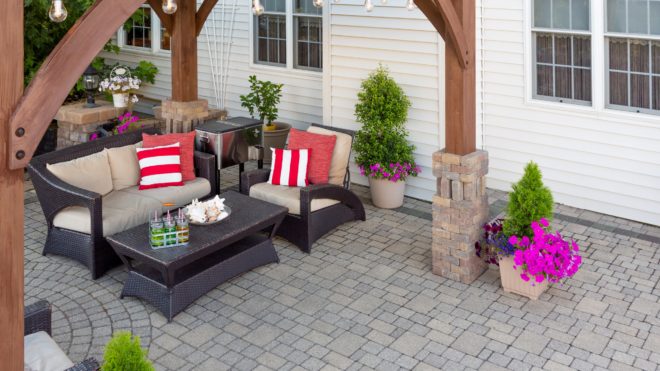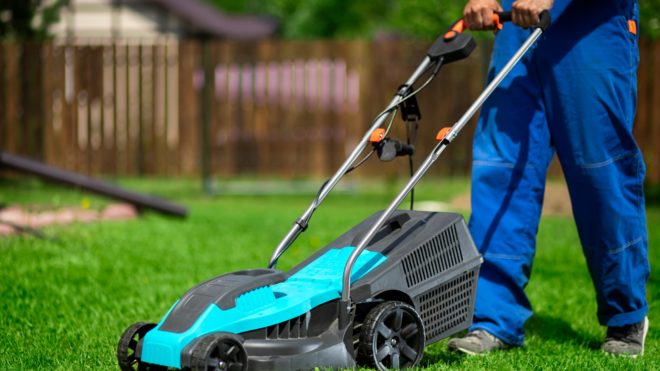A retaining wall is a landscaping element that acts as a protective layer for your foundation, prevents soil from eroding, and at the same time, looks aesthetically pleasing. A stone…
Blog

10 Things To Know About Paver Patios
Patios are a great addition to any home and landscape. They are great for relaxation, outdoor dinners, and outdoor recreational activities outside your backyard. The material you choose is the…

5 Tips on How to Maintain a Lawn at All times
A lush green lawn at all times is an American homeowner’s dream. But, it is not an easy feat to achieve, especially if you are a novice when it comes…

What is Landscaping? Everything You Need To Know
Landscaping refers to the practice of enhancing the exterior of your home by adding landscaping elements. It includes strategically placing softscaping and hardscaping elements to improve the aesthetics and functionality…

8 Basic Principles of Landscape Design
Landscaping is the art of transforming your home’s exterior into a functional and aesthetic place. Landscaping includes strategically adding softscaping and hardscaping elements such as plants, flowerbeds, trees, fire pits,…

The Difference Between Hardscaping and Softscaping
A well-designed landscape can enhance the beauty and value of any home. It also acts as an ideal space for relaxing and rejuvenating in nature. However, designing an incredible landscape is indeed tough without balancing the essential landscaping elements—hardscaping and softscaping. Knowing the differences between these elements and precisely incorporating them into your landscape can help you develop a better space.
Here’s everything you need to know about hardscaping and landscaping.
What is hardscaping?
Hardscaping refers to all the non-living elements in your landscape that are solid and unchanging, hence are called hardscapes. Hardscaping elements include various features such as walkways, pathways, fountains, patios, decks, statues, outdoor kitchens, and retaining walls.
What is softscaping?
Softscaping is used to describe all the living elements of your landscape. They keep changing and are softer to touch. Hence, they are called softscape elements. They include plants, shrubs, trees, grass, and flowers.
How does softscaping differ from hardscaping?
The significant difference between these elements can be described according to the following factors.
Hardscape is more permanent
Hardscaping elements are often designed with stone and cement are of fixed nature, so once you add them, you cannot remove them without a lot of work. They also are pretty expensive to add, so you need to introduce them after carefully considering all the variations.
Softscaping is more changeable
Softscaping is all about the living things in your landscape that keep constantly growing and changing. Every day you can notice some change in your landscape due to hanging softscaping elements. They are also affected by the seasons, so when adding softscaping features to your landscape, you need to consider these factors.
Softscaping requires more maintenance
As softscaping elements are alive, they need daily care and maintenance to thrive and grow. You need to water, prune, trim, fertilize, and de-weed to ensure your softscaping elements are healthy and look aesthetically pleasing.
People often occupy hardscaping
If you want to entertain guests in your garden or like to spend a lot of time outdoors, you would undoubtedly require hardscaping elements in your landscape. Decks, patios, walkways, outdoor kitchens, and fire pits are essential for people to sit and enjoy the outdoors. It is up to you to creatively design the elements.
Softscape adds life to your landscape
You can build various hardscaping elements to your landscape, but without the softscaping details, it would become lifeless and cold. Softscaping smoothens the harsh edges created by hardscape elements in your landscape.
Hence, it is essential to add both elements to your landscape. If you don’t have the time to maintain the softscaping features, you can opt for low-maintenance plants and trees that work well with your landscape design.
About us
We have been serving the Delaware area for over 30 years. We specialize in residential and commercial landscaping and hardscaping and offer a broad range of services for lawn care needs. So whether you want an aesthetically pleasing landscape in your lane, a patio for your home, or a professional ground around a commercial area, we got you covered. Get a free quote by calling us at (302) 653-6246, leaving an email at info@a1kevinslandscaping.com, or filling out our online contact form.

